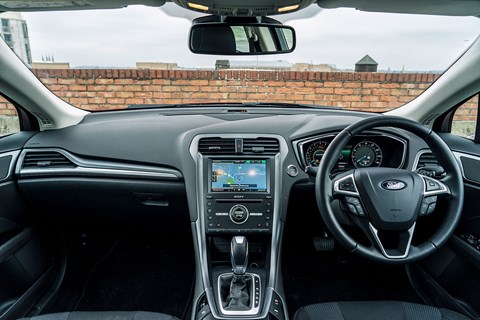► We live with new Ford Mondeo Estate
► Ours is the 2.0 TDCi in Titanium spec
► Has Ford’s everyman wagon still got it?
Month 9 running a Ford Mondeo TDCi estate: the conclusion to our long-term test
Much like Christmas is for kids, the Mondeo was a long time coming, and gone all too soon. Ford in the US released its version, the Fusion, at the beginning of 2014, but Europe had to wait a whole year for the Mondeo-ised car with its more suitable engine range. Now, after nine months on the fleet, we’ve swapped ours for another Ford and are about to find out how much we’ll miss it, if at all.
That we’ve replaced it with a new S-Max pretty much sums up the Mondeo’s problem, one all traditional family cars face. No matter how good the Mondeo is, far fewer drivers actively choose one, its ‘Mondeo man’ market eroded by the lure of premium badging and more versatile MPVs and SUVs. In its heyday Ford sold well over 100,000 Mondeos in the UK each year; now it’s less than 30k because no-one wants an ‘ordinary’ car.
That’s always been the Mondeo’s conceit, though. Right from the beginning in 1993 it looked ordinary, when to drive, and to live with, it was anything but. This time the Mondeo looks far from ordinary. Wide, and sleek, square-jawed and confident, it’s a fantastic looking car, whether you go for the rakish fastback hatch or handsome wagon. This time the Superman suit is on the outside, not hidden away. The question is, is it plain old Clark Kent underneath?
First impressions suggested it was the Man of Steel through and through (aluminium hasn’t yet made it below the premium sports saloon market). The cabin is vast and brilliantly hushed at speed, which has historically been a Ford weakness. Since my driving diary basically involves endless long airport runs punctuated by shorter ones ferrying kids around, that’s a pretty appealing combination. The boot isn’t the biggest in the class but seemed big enough to swallow family junk too, including bikes, which was handy because my bike rack didn’t fit because of the Mondeo’s fat bootlid lip, and the long service intervals proved equally practical. The car went back at 13,000 miles, still with 5000 to go before needing its first oil change.
We went for the top-dog (at the time) 178bhp 2.0 TDCi, and although I was initially less than amazed by its kick (the 8.7sec 0-62mph time compares badly with the equivalent Passat’s 7.9sec) and its struggle to average 40mpg, it proved gutsy in the mid range and the 450+ mile range was welcome. As was the smooth-shifting twin-clutch transmission, which did a great job of maximising the engine’s 295lb ft of torque, and whose mapping was so good I rarely touched the steering-wheel paddles, preferring to stir the stick between Drive and Sport as needed. And economy did improve as the engine loosened up. Disappointing 38s became more acceptable 40s, although even driving like we had 300 gallons of unset jelly sloshing around in the boot, 50mpg proved impossible to achieve.
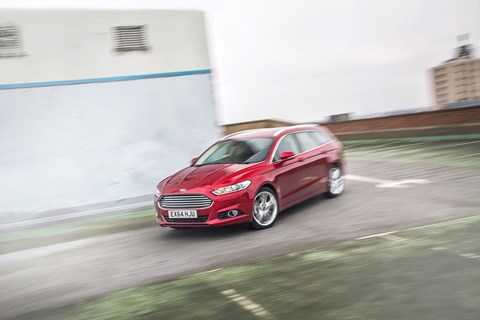
Some CAR staffers reckoned the old Mondeo dynamic magic was equally elusive. The fact that there’s a dedicated Sports suspension option in the brochure backs up the subjective feeling that the standard set-up has been softened. We’re not talking mush here. Fully laden and tanking on, the body control was too soft, but in normal use it seemed well judged, and still displayed the kind of steering feel, precision and sense of involvement you simply don’t get in a Passat.
What you do get with the Passat though, is a genuinely premium-feeling cabin. It’s not so much the Ford’s design that’s at fault, but the materials that spoil the experience. The Mondeo is less claustrophobic but it looks and feels cheaper (though doesn’t sound it, not with our car’s excellent optional Sony hi-fi). A familiar gripe? Fifteen years and two generations ago we were saying exactly the same thing.
But 15 years ago kit like lane-keeping assist, collision warning systems and airbag seatbelts were still concept car material. Now they’re available to everyone, but do you want them? We tried to leave the steering assist (which warns if you’re about to leave your lane and can actively steer you to keep you from straying) switched on because, like ESP, there’s no point in having it otherwise. But it was simply too annoying and too inconsistent. Sometimes the steering correction makes the front end feel as wayward as an Alfa 4C. Great idea, best avoided.
Much like the arthritic touchscreen sat-nav, whose cursor is about as enthusiastic about being dragged across the map as London social housing evictees. And the airbag seatbelts are best avoided too if you’ve got small kids, something I can only say because I never needed their help. My kids though, needed help to put the belts on every time we travelled. If you want to see rage like you’ve never seen rage before, watch a seven-year old trying to wrestle one of the airbag belt’s strangely fat buckles into a socket that’s not mounted remotely wide enough to work with a proper child seat. Given the car’s family-friendly intentions, it seems a strange gaffe.
Count up those demerits, the fact that a Passat is quicker, more economical and feels more special inside, or that you could have a thinly specced BMW 3-series wagon for the £31k our car cost, or a more practical and more fashionable SUV and you can see that the Mondeo’s glory days are over. But you know, I’m going to miss it, the relatively uncomplicated dependability, the elegantly understated styling and cleaning that giant chrome grille with my little boy until it absolutely gleamed. And when it did, I felt a little proud, not a familiar feeling for Mondeo man, I’m fairly sure.
By Chris Chilton
Month 8 running a Ford Mondeo 2.0 TDCi: Mondy goes banger racing
The original Ford Mondeo was so unbreakable it was outlawed from banger racing. We take our long-term Mondy back to its tough-guy roots…
‘Sunday, 1pm. National Bangers,’ reads the fixture for a meeting at Arena Essex Raceway. ‘No Mondeos.’ If you’ve read anything about the new Mondeo you’ll already know that it’s one of the toughest cars in its class when it comes to keeping you out of trouble, and safe in a smash should the worst happen. Collision-avoidance auto-braking, lane-keeping assist and airbag seatbelts in the rear are all available as options, and all fitted to our five-star NCAP long term Titanium wagon. But it turns out toughness is in the blood. The original first-gen Mondeo is so tough it is effectively outlawed from ordinary banger racing classes to give the other cars a fighting chance.
Short oval racing rarely gets a mention in mainstream media, seen as the grubby, blue-collar poor relation to more glamorous (but often less action-packed) series like F1, or impossibly middle-class events like Goodwood. But there are races happening up and down the country every weekend. You’ll have seen the cars being hauled to races on the back of trucks; some of you might have seen the ‘Banger Boys’ documentary on the History Channel. Oval racing can be fast, exciting and it’s comparatively affordable, whether you’re watching or driving.
There are all sorts of oval formulae, from 1000cc Minis driven by 11-year old kids, to Brisca F1 stock cars – custom single-seat racers with thundering V8s and huge roof-mounted wings. You might be surprised to learn that it’s not all about destroying the other cars. Some series are non-contact, but bangers, though ostensibly a race to the line, has always been about the bust-ups.
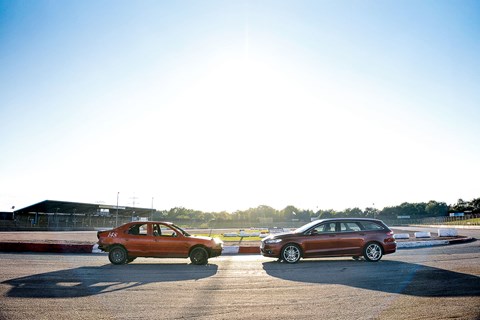
We’ve come to Essex Arena near Purfleet, a stone’s throw from the Dartford Bridge, to find out more. Founded on the remnants of an old cement works site by legendary racer Chick Woodroffe, Arena Essex held its first car race in 1978, later adding speedway, and now drifting days too. Chick departed for the great oval in the sky a few years back, but his daughter Debbie meets us in the offices overlooking the track and points us in the direction of John Harris, who’s head is buried in the engine bay of a windowless Mondeo.
There’s the trusty Zetec motor under the bonnet, but what’s that? A twin-choke downdraught carburettor? John explains that you can run the original injection system, but it’s simpler to switch to carb-fuelling on a custom manifold, even if you have to stump up for a Megajolt ignition set-up to replace the redundant ECU. Other than ditching the original fuel tank for a tiny cell behind the driver’s seat, and junking every bit of extraneous trim, the Mondeo appears exactly as it would have done when receiving its PDI two decades earlier – though with this much panel damage, we doubt it would pass.
So what is it about the Mondeo that makes it such a mighty banger? ‘I think it’s the subframe, and how it mounts to the car,’ says John. ‘The floor of the car will bend before the frame does. You can just keep going.’ Ironic that the very trait that helped relegate the original Mondeo to a middling three-star NCAP rating makes it a brilliant banger winner.
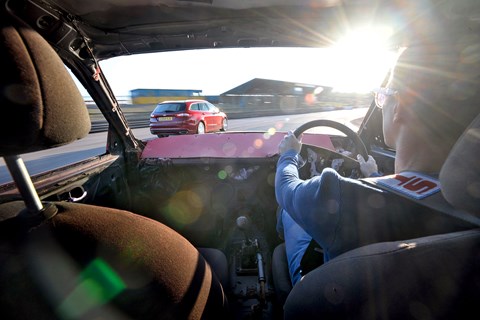
The Mondeo’s durability is a desirable trait in this sport because unlike the Sierra Sapphire stock car parked next to it in John’s yard, which effectively features a home-built box-section spaceframe chassis that extends beyond the bodywork, the banger comes with no additional metalwork to protect its radiator, wheels or suspension.
We head out on to the track, a quarter-mile oval buried beneath the natural banking that forms the spectating area for those not in the stands. This one’s a sealed surface but there are other venues around the UK still running on shale. John hurls the banger Mondy through a few fast laps while we wait at the side, finishing with a body-lurching hand-brake turn that morphs into a dramatic tyre-smoking burnout.
‘Jump in,’ he says through the glassless screen aperture, ‘I’ll take you round.’ I climb into the bog standard 1990s road-car seat then buckle up the proper racing harness, an odd mixture. There’s no dashboard, no instruments no other interior trim. That diet should help pep up the performance and tighten the handling, but if I’m honest, I’m not expecting fireworks. This is a bog-standard 20-year old Mondeo on a track so short you’d struggle to get out of second gear. I mean, how fast can it feel?
Answer: very. The rush of wind batters our faces as we tear down the straight before John pitches the car hard into the first right-hander. The back tyres slide wide and a giant puddle of filthy water from John’s footwell catapults straight over the tunnel onto, and into, my shoes. He gathers the slide neatly, right foot feathering the throttle on and off, on and off, to keep the nose tucked in tight to the giant kerb. Then it’s another short sprint up the opposing straight and into the other curve. We’re one car on the track and my heart is pumping. The thought of doing this with 30 cars fighting for every inch of this tiny stretch of tarmac, and another 10 dead ones strewn along the way, is hard to imagine.
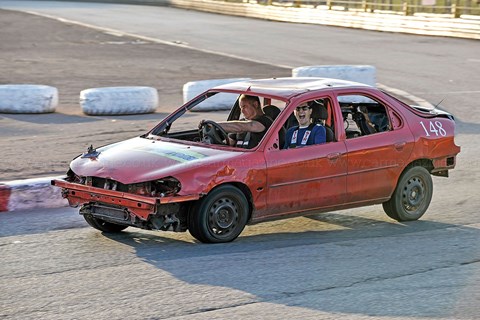
John’s an old hand at this. Racing before the Mondeo was even a twinkle in Henry’s tool chest, as JD Bangers he runs a £90 Banger Stunt Experience with Debbie where you can learn handbrake turns, J-turns and the infamous pit manoeuvre beloved of banger racers and US pursuit cops, involving nudging the rear of the car ahead from the side, sending it into a spin. Spectacular, but safe.
Was it always so? Has safety improved since the days when Austin Cambridges were the banger of choice? ‘God, yeah!’ exclaims John. ‘These days the drivers have fireproof overalls and balaclavas, back then you could race in tracksuit bottoms, whatever you had on. To keep the insurance people satisfied we installed safety fences at the track and we have proper fuel tanks now. We used to use old fire extinguishers and turn them upside down. But the nozzles used to snap off and petrol would be all over the place.’
In his younger days John was a wrecker rather than a racer. ‘I never lapped, I used to like to turn round at the bottom bend and wait for the cars coming towards me. Anyone who gave me a hard time, sooner or later they’d meet me in the corner.’
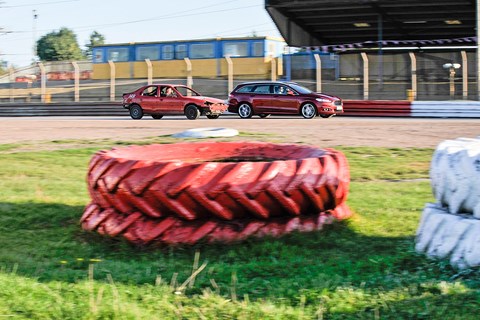
The Mondeo sounds like it would be perfect for that sort of destructive mission but, despite its inherent toughness, the ubiquitous Ford seems to have changed the style of competition.
‘The Mondeos have killed it,’ says John. ‘People spending £400 on a set of tyres don’t want to get them punctured and you’ve got guys taking their cars to rolling roads to tune them up. You don’t want to put £600 into a car and have it trashed after half a lap.’ It’s less about crashing and more about racing.
Will new-shape Mondeos ever make it onto the banger circuit? John doesn’t think so, but with millions of first generation examples built and now available for a pittance, it doesn’t sound like the biff-’em boys are about to run out of donors anytime soon.
As for our car, it’s proved tough enough to stand up to 11k miles of abuse with just an underbody rattle from a misaligned fuel pipe that needed reshaping, and a sticky sunroof, the latter less obviously fixable say the techs, and requiring a two day headlining-drop investigation. Two days? Can’t imagine John’s crew standing for that. Maybe we should borrow from the banger. Bolt a steel plate over the top and be done with it.
By Chris Chilton
Month 7 running a Ford Mondeo Estate: is it just us that like the red paintjob?
Six months and almost 10,000 miles after the Mondeo joined us, I’m starting to notice more of its brethren on the road. But not one of them has been coated in the rather fine Ruby Red metallic our car wears. It makes sense to specify bright colours for test cars – it helps them pop out of photographs, but often leaves you driving a car you wouldn’t even consider buying. But in this case, the red really makes the best of the Mondeo’s starched-collar lines. It’ll be interesting to hear from our local Ford dealer whether it’s a trifle too sudden, and might actually hurt the resale values. We’ll find out when it goes in next week to have the jammed sunroof and mysterious underbody rattle attended to.
Those other Mondeos we’ve seen are mostly wearing puny 16 and 17in wheels, rather than the optional 19s on ours. These are predominantly reps’ cars after all, and big rims cost more and hurt fuel consumption to the tune of 1.2mpg and 2g/km of CO2. Sounds inconsequential, until you remember our average is still hovering below 40mpg, despite what the optimistic trip computer would have us believe.
The ride is surprisingly good on the 19s, but as we’ve mentioned previously, the new Mondeo feels considerably less taut than the old one, and there’s no adaptive damper option to firm things up. However, it turns out that there is a sports suspension option, again with fixed-rate dampers, available at extra cost. Check back next time to see how it compares.
By Chris Chilton
Month 6 running a 2015 Ford Mondeo Estate: a guided tour
Our Mondeo in pictures. Stuff we like – and stuff we don’t
Load management? Posh name for boot rail
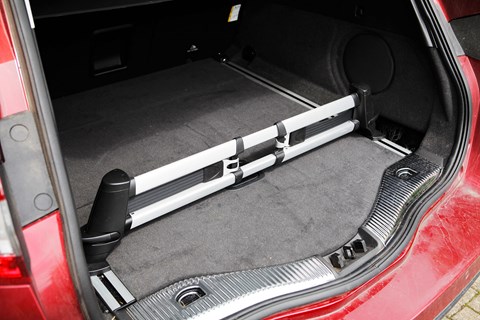
The boot isn’t the biggest in the class but it’s still deep enough to let you lose a couple of shopping bags into its abyss. The optional £250 Load Management System comprising a floor-mounted sliding rail and cargo net sorts that, and is fully removable when you need use of every single square litre.
Useful stuff for those who drive while asleep
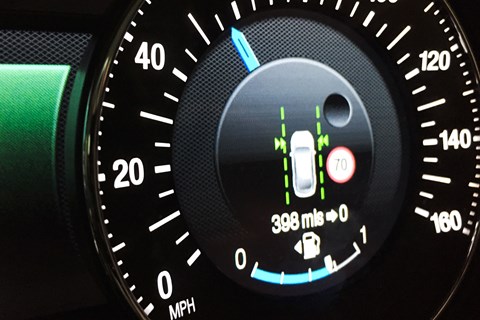
Safety aids feature big in the Mondeo package. We’ve tried the Lane Keeping Aid (standard on Titanium trim; we normally leave it switched off) but fortunately not the Active City Stop auto-braking function (£200) or seen the £175 inflatable rear seatbelts in action.
Who let that sunshine in here?
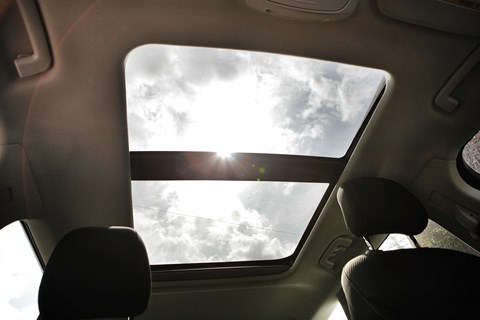
The £900 sunroof floods the cabin with light, but there’s not much chance of any other kind of flood happening because the opening function is kaput. The whole lot was covered up in July when I hired another roofbox from Iain at the ever-helpful A2outdoorhire.co.uk for a camping trip.
Sat-nav screen illegible in sunlight
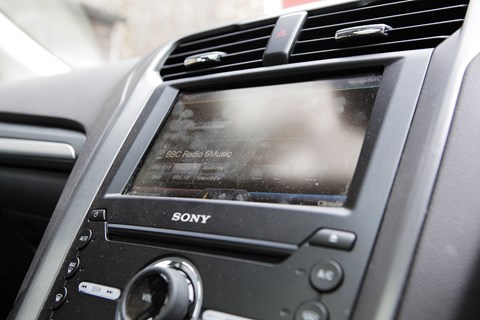
We’ve hated on the touchscreen nav before – it’s horribly laggy and the buttons are minute. But here’s one more whinge: it’s almost impossible to see in sunlight. On the plus side the 12-speaker Sony sound system does a great job of filling the vast cabin with music.
By Chris Chilton

Month 5 running a Ford Mondeo: a tale of two ‘world’ Fords
Bumped into Mondy’s van cousin this month, another of Ford’s world cars. In Britain we’ve known the Transit since the 1960s, but it’s a relatively recent arrival in other markets, including the US, where it replaced the ubiquitous Econoline, favourite of kidnappers, bank robbers and maybe a few law-abiding types too.
It can swallow loads up to 15 cubic metres, comes with car-like gadgets including adaptive cruise and lane-keeping alert, but no-one’s going to accuse this one of looking like an Aston.
By Chris Chilton
Month 4 running a Ford Mondeo estate: why did they cover the door bins?
It was interesting to discover that despite its huge external dimensions (and generous rear seat space), the Mondeo’s boot is actually smaller than the new Volkswagen Passat’s. But it’s still easily big enough to swallow my kids’ bikes, or a Jessop’s worth of camera gear, as I discovered on a trip to McLaren this month, so I’ve no complaints there. Particularly as it comes with a spare wheel, which I much prefer over a can of tyre foam.
But interior storage is another matter. The deep armrest cubby is handy, and there are two big cup holders that can double as phone dumps, but the cubby beneath the centre console is hard to access because of the huge pillars on either side. I tend not use it, and put stuff in the door bins instead, but for some obscure reason they’re partially covered. Stuff is forever sliding into the covered section at the back of the door and you’ve got to get all James Herriot and shove your arm in elbow deep to retrieve it. Not achievable while driving.
By Chris Chilton
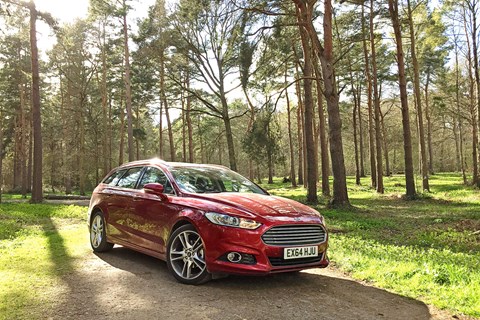
Month 3 running a Ford Mondeo: please fasten your airbags
Context is everything when you’re testing cars. A machine that impresses in isolation can suddenly feel decidedly less epoch-defining when faced with the class best. Which is why our Mondeo didn’t win the mini-test at the front of this month’s mag. The boot is big, but not biggest. The interior quality is okay; others do it much better. But still the Mondeo is proving a real asset on fleet. It’s huge inside, relaxing at a cruise, and fun to hustle, although body control has turned out to be surprisingly soft when loaded, and there’s no adaptive damper option to tighten it up, something key rivals do offer.
One option the Mondeo can claim sole bragging rights over is the rear seatbelt airbags. Slightly broader than a normal belt, they contain a small airbag that can inflate in 40 milliseconds to distribute pressure more evenly across the torso, and better control head and neck motion in a smash. At £175, they’re so cheap you can hardly refuse, and to an adult passenger feel at least as comfortable as a normal belt.
Things get trickier when you involve child seats though. It’s harder to feed the broad strap through my kiddy Recaros’ slots, and my son finds the jumbo buckle a real pain to drive home. On top of that, the most junior Chilton is now terrified of having a crash because she thinks she’ll be subjected to a bomb blast at point blank range should the thing ever go off. Maybe that’s just a polite way of telling me to slow down.
By Chris Chilton
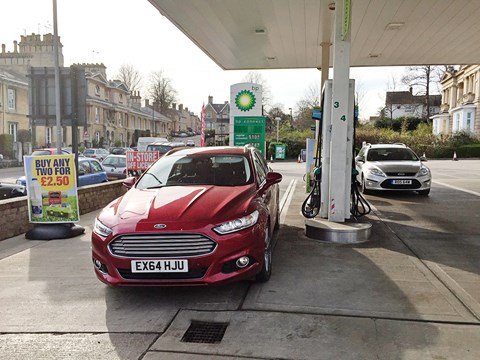
Month 2 running a Ford Mondeo: fuel economy
The fuel figures in last month’s ‘Hello’ report were based on one 250-mile journey where I kept my distance from the right pedal like it had ebola because of meandering 60mph traffic and in deference to the motor’s youth.
The result was 48.9mpg, some way off the 56.5mpg official figure, but way better than the 38.9mpg I achieved over the course of 1153 miles this month while making lots of short urban runs and eating motorway like I was trying to outrun a Hollywood cyclone.
By Chris Chilton
Month 1 running a Ford Mondeo Estate: the introduction
Blimey, you took your time! Almost three years after it was launched in the US, Ford’s Fusion has landed on this side of the pond with a new, but very familiar badge: Mondeo. Ford puts the delay down to the restructuring of its business, which meant it didn’t have the capacity to build European volumes straight away. Plus, it allowed time to ready the car for a range of new Euro-friendly engines.
The Mondeo might have been late to the market, but its arrival at CAR couldn’t have been better timed, coinciding exactly with my birthday. Some men hit 40 and fight back with affairs and Fireblades. I capitulated to the slowest, most sensible long-termer I’ve run in 15 years of doing this job.
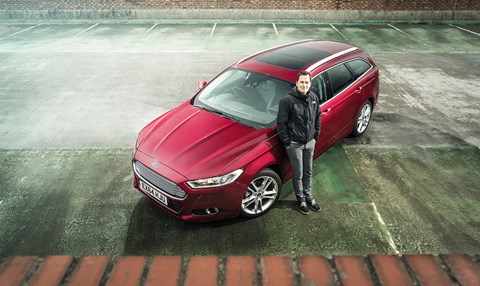
But by God it’s good. Maybe it’s an age thing; maybe it would have been rubbish last week, but right now, from where I’m standing (in the corduroy trousers section at Greenwoods) it’s a seriously impressive bit of kit. Handsome, with that imposing Aston-esque grille and confidently creased skin, and genuinely huge. At 4.9m, this is a seriously big car, both outside and in.
Technically, there are three body styles, but the four-door saloon exists only as a tax-friendly 99g/km hybrid. The others are the rakish fastback hatch, and the smart-looking wagon you see here, which commands a £1250 premium. The base petrol engine is the improbably small 1.0 Ecoboost triple, the only other spark-ignitors being a 158bhp 1.5 and a surely-exists-in-the-brochure-only 238bhp 2.0-litre turbo. Diesels start with a 114bhp 1.6TDCi, whose potential 79mpg isn’t the only reason you’ll last longer between fills. At over 12sec to 62mph it’ll take eons just to reach the next fuel station.
The next jump is to a more spritely 148bhp 2.0 TDCi and then on to the range-topping 178bhp 2.0 fitted to our car. None of the new Mondeos is particularly rapid in the face of VW and BMW opposition, and we reckoned the 178bhp car’s 8.7sec 0-62mph was about the bare minimum our spoiled AMG-weaned right feet could tolerate. Besides, when equipped with the optional Powershift six-speed dual-clutch ’box (£1370), there’s absolutely no difference in fuel figures between the two 2.0 diesels, both rating 58mpg on the combined cycle and emitting the same 128g/km of CO2. The manual alternative is almost 5mpg thriftier, incidentally, and 11g/km greener.
Trim levels are simple to understand and generous. Even bottom-rung Style gets DAB, 8in touchscreen, dual-zone climate and 16in alloys, while Zetec, whose chrome window surrounds and foglights make it look far more appealing, adds all-round electric windows, more seat adjustment and cruise control. But we mirrored the choice of over half of Mondeo buyers and chose Titanium trim, with sports seats, sat-nav, auto lights/wipers, lane departure warning and 17in rims.
To that we added the only remotely vibrant paint option in the palette, 19in wheels, panoramic sunroof, keyless entry, Ford’s autonomous braking system, upgraded Sony touchscreen nav and a few other morsels, which pushed the base price from £26,865 to £31,135. A lot for a rep car with cloth seats, but a lot less than for a smaller, less lavishly equipped 3-series.
What do we think so far? It feels like a big car inside, but from the driver’s seat too, at least when parking, with its chunky swept-back pillars and poor turning circle. Get it moving though, and it shrinks like a bag of crisps at 500 fathoms. It’s surprisingly agile, flicking through corners with the zeal of a smaller car, the body control that holds it all together on a B-road not coming at the expense of ride comfort. The biggest impression is of the overall mechanical refinement. It’s impressively hushed and comfy, and for all our obsessing over on-limit handling, isn’t that what really counts in a hard-working car like this?
The only real letdown is the centre console. Step out of the new Passat into the Mondeo and it feels decidedly low rent. And we’re going to have to get used to using the SYNC multimedia system’s voice-activation because the screen’s icons are too fiddly. There’s much to like here though, the big question being whether anyone will notice. The shift to SUVs has decimated the market for this kind of car. Are you about to make the same move? Our Mondeo has six months to change your mind.
By Chris Chilton
